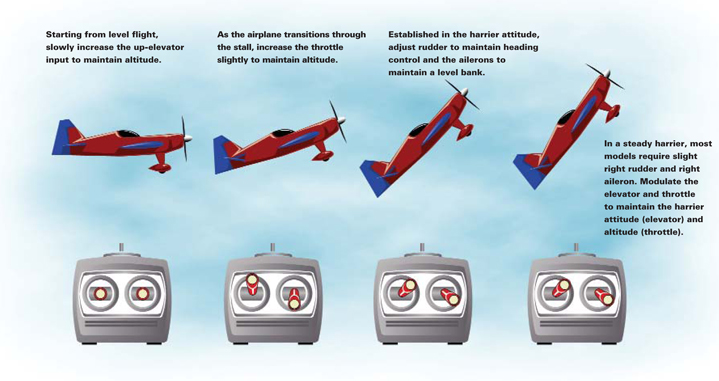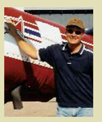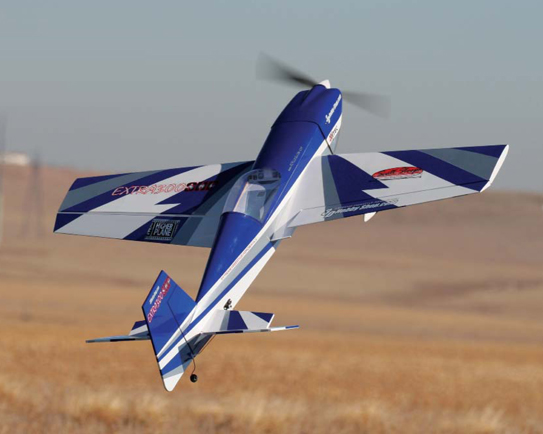|
||
| GETTING STARTED
What makes an RC airplane a good 3D model? From my perspective, there are three fundamental differences between traditional sport airplanes and 3D airplanes. 3D airplanes have: 1– a much higher thrust to weight ratio, Fortunately, the rapid growth of electric flight technology has allowed the development of a wide variety of affordable highperformance 3D designs. Explore 3D flight only when you can competently fly basic aerobatics with a low-wing sport aircraft. Many pilots find that using the rudder effectively is the hardest part of learning 3D flight. Although most sport airplanes have a rudder, many pilots virtually ignore it. In contrast, 3D flight requires rudder proficiency. Most sport pilots, if they use the rudder at all, just use it to coordinate turns by combining rudder with aileron inputs. 3D flight requires the completely independent use of all four flight controls. As one of 3D flights fundamental building-block maneuvers, the harrier requires the pilot to de-link the rudder and ailerons, as you will see. |
||
|
||
 |
||
| the wing and has not yet stalled. Initially, I recommend that you get comfortable transitioning between level cruise and slow flight. The ability to maintain altitude and heading during slow flight is critical to a smooth transition to the harrier. When youre comfortable with slow flight, youre ready to fly the harrier. Practice the transition with enough altitude to allow recovery from an unexpected stall or spin. Use high rates on all controls, and start in level slow flight directly in front of yourself and flying into the wind. As the model slows, the drag increases. Increase the up-elevator and thrust to maintain altitude. The wing will stall at some point in the deceleration, and one tip may drop slightly. If the wing drops, add enough rudder to compensate. Some models will transition smoothly while others will have a marked wobble, or wing-rock. The thrust required for a harrier is significantly greater than that for slow flight. Learn to judge the throttle setting to maintain altitude. Once established at approximately 45 degrees nose-up, modulate the elevator input to maintain the pitch attitude and control the throttle to maintain altitude. At this point, use the rudder to steer the model and the ailerons to control the bank angle. The high AoA poses some control problems. With very little airflow over the controls, the effects of torque and P-factor will be obvious. Most of my models require that I hold some right aileron and right rudder to maintain a constant heading when flying harriers. To transition back to conventional flight, increase the thrust towards full power while you reduce the pitch attitude with the elevator. The model will accelerate rapidly and fly away. If the maneuver goes poorly, the best recovery technique is full throttle and a reduction in the pitch attitude back to a normal flying AoA as you regain airspeed.
BANK ANGLE INSTABILITY Many models will display bank-angle instability when flying the harrier. Although generally lumped together and called wing rock, there are two distinct types of harrier instability: wing rock and rudderinduced bank changes. Lets look at wing rock first. This is an aerodynamic tendency for a model to oscillate in bank during wings-level fixed-heading harrier flight. We dont have all the answers about what causes it, but most experienced pilots agree that this lateral instability is caused by uneven airflow separation over the wings, coupled with yaw instability that results from some blanking of the vertical stab/rudder area. Real-world testing has proven that lighter wing loadings coupled with thin airfoil sections can reduce wing rock. More important than its cause, however, is the solution to counter wing rock. For true cyclical wing rock, the only effective counter is an aileron input on cycle keeping the wings level. On certain models with dramatic wing rock, this may be hard to accomplish.
Rudder use will also cause a bank-angle change during harriers. Although the rudder is used to change heading during a harrier, most models will also roll in the direction of the rudder input; i.e. left rudder, left roll. This isnt wing rock. Countering bank angle changes induced by the rudder requires that you think ahead of the model. If you add left rudder to turn to the left, youll likely need to add right aileron at the same time to keep the wings level. This is perfectly usual. Remember, if you use the rudder to change heading, you need to use the ailerons to keep the wings level!
COMMON MISTAKES 1– Poor setup and transition through the stall.
SUMMING IT UP 3D flight has opened RC flight to an entirely new generation of pilots who promise to reinvigorate this great hobby. Although commonly linked to the Ace of the Base or TOC-level pilots, 3D flight is also quite possible for sport pilots of all skill levels. Learning to fly the harrier is the perfect first step into this new flying style. It is also a step that I hope all of you will consider taking. 3D flying is fun and rewarding, and the confidence you gain when you operate your aircraft beyond the stall is priceless for all of your flying. Until next time, remember, aerobatics make the world go round. |
 Fly RC Magazine WE LIVE RC
Fly RC Magazine WE LIVE RC
 Scott Stoops is a commercial pilot for United Airlines who flies a full-scale Sukhoi 26MX in IAC competition for fun on his days off. His new book, The Pilots Guide to Mastering Radio Controlled Flight, is available at www.rcpilotguide.com. We are very pleased to offer Scotts insights to our readers, and look forward to bringing you additional such pieces in the future.the editors
Scott Stoops is a commercial pilot for United Airlines who flies a full-scale Sukhoi 26MX in IAC competition for fun on his days off. His new book, The Pilots Guide to Mastering Radio Controlled Flight, is available at www.rcpilotguide.com. We are very pleased to offer Scotts insights to our readers, and look forward to bringing you additional such pieces in the future.the editors
